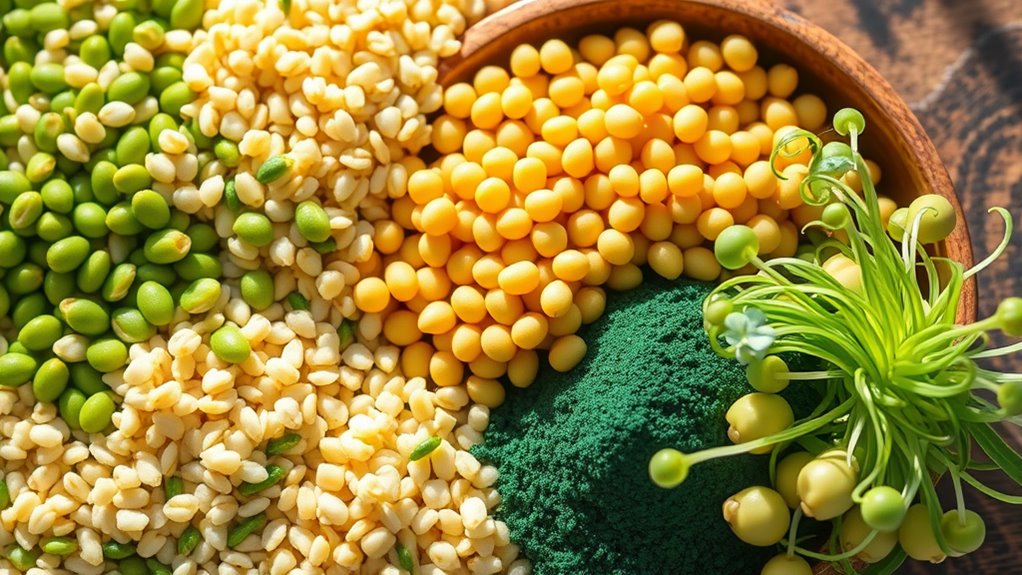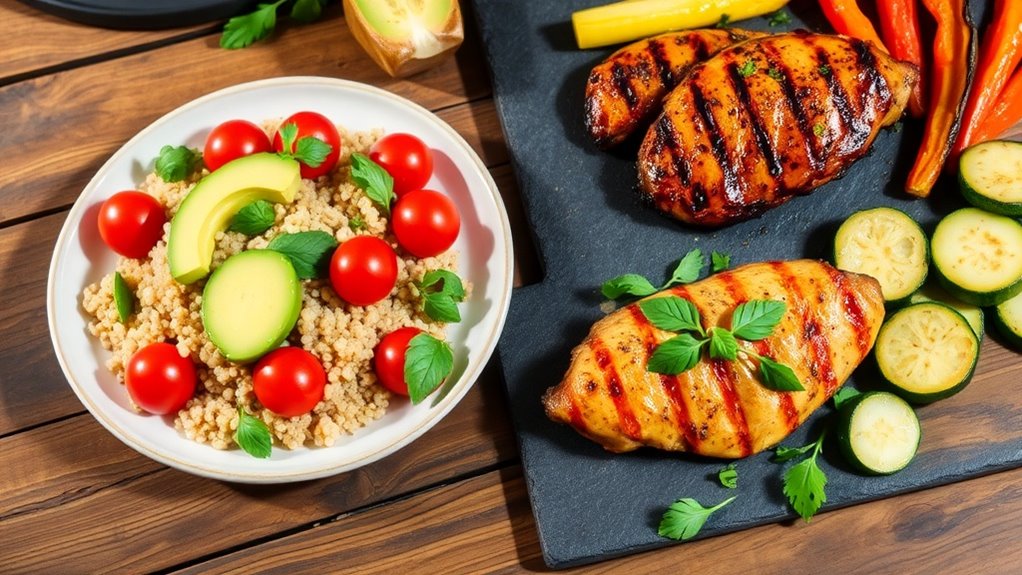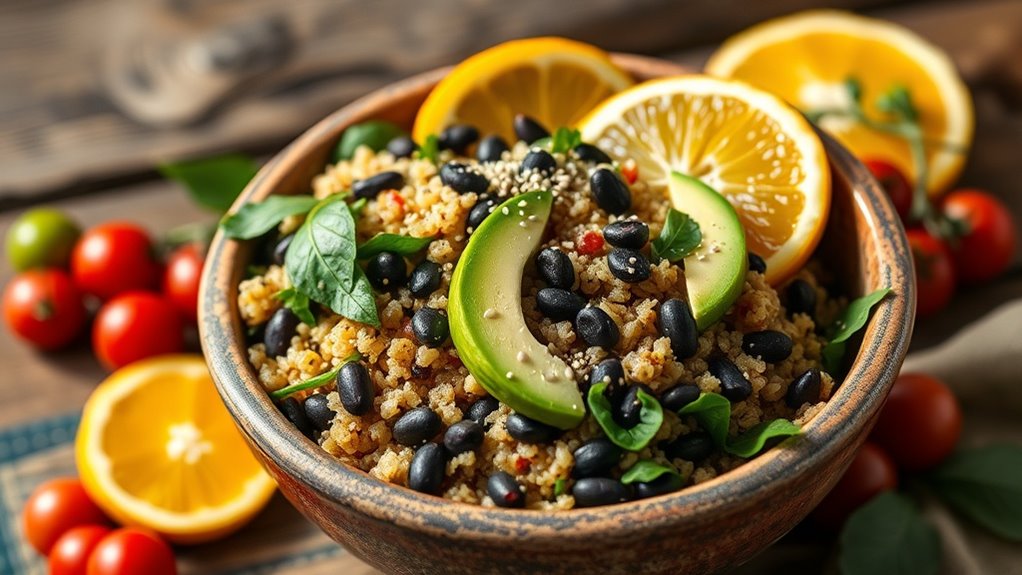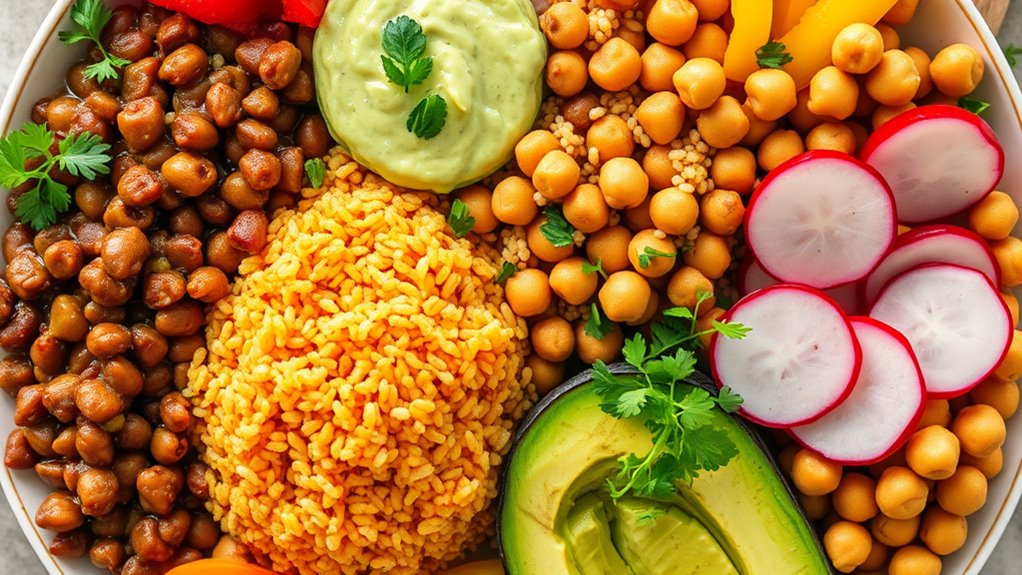Plant-Based Protein Sources You Never Knew Existed!
If you’re searching for unexpected plant-based protein sources, you’re in for a treat! Explore spirulina, a superfood algae packed with protein, and teff, a tiny grain bursting with nutrients. Edamame offers young soybeans loaded with fiber and nutrients, while nutritional yeast adds a cheesy flavor and B vitamins. Chia and pumpkin seeds deliver healthy fats and protein, and quinoa is a complete protein grain. Green peas and almond flour can boost your meals too. Stick around to uncover even more hidden gems!
Key Takeaways
-
Spirulina: This superfood algae is packed with around 60% protein by weight, making it a potent plant-based protein source.
-
Nutritional Yeast: Offering about 8 grams of protein per two tablespoons, it adds a cheesy flavor to dishes without dairy, ideal for plant-based diets.
-
Teff: This tiny gluten-free grain provides roughly 9 grams of protein per cooked cup, along with essential amino acids and micronutrients.
-
Lentil Pasta: A unique alternative to traditional pasta, it delivers around 20 grams of protein per serving and is gluten-free.
-
Edamame: Young soybeans that pack approximately 18 grams of protein per cup, making them a versatile and nutritious addition to meals.
Spirulina: The Superfood Algae
When you think about nutrient-dense superfoods, spirulina often comes to mind as a powerhouse of plant-based protein. This blue-green algae boasts an impressive amino acid profile, making it an ideal supplement for anyone seeking to elevate their intake of vegan proteins.
Not only does spirulina offer around 60% protein by weight, but it also contains essential vitamins and minerals that boost your overall health. Additionally, spirulina is recognized for its positive environmental impact, making it a sustainable choice for those looking to reduce their carbon footprint.
Incorporating spirulina into your diet is straightforward—add it to smoothies, sprinkle it on salads, or mix it into energy bars. By doing so, you’re not just enhancing the protein content of your meals; you’re also accessing its antioxidant properties.
Embrace spirulina, and access the potential of this superfood for your plant-based journey.
Teff: the Tiny Grain Packed With Protein
If you’re looking for a protein-packed addition to your meals, teff might just be your new favorite grain.
With its impressive nutritional profile, this tiny powerhouse offers more than just protein—it’s also rich in fiber and minerals.
Let’s explore how you can cook with teff and incorporate it into your diet.
Nutritional Profile Highlights
Teff, a diminutive grain native to Ethiopia, offers an impressive nutritional profile that makes it a standout among plant-based protein sources. You’ll find that just one cup of cooked teff contains about 9 grams of protein, which rivals other grains.
Teff is also rich in essential amino acids, particularly lysine, often lacking in other grains. You’ll love its high fiber content, fostering digestive health and promoting satiety.
Additionally, teff is a powerhouse of micronutrients, boasting calcium, iron, and magnesium. This tiny grain’s gluten-free nature makes it accessible for those with dietary restrictions.
With such a robust nutritional makeup, teff deserves a spot in your pantry as a versatile and wholesome ingredient for various dishes.
Cooking and Serving Ideas
With its impressive nutritional profile, teff opens the door to a variety of delicious cooking and serving possibilities.
You can use teff flour to create gluten-free pancakes or to thicken soups, adding a rich, nutty flavor. In addition, cook whole teff grains as a hearty base for salads or bowls; its unique, slightly earthy taste marries beautifully with roasted vegetables or fresh greens.
Try using teff in place of rice or quinoa to elevate any dish. You might also consider making teff porridge for breakfast, topped with fruits and nuts.
Finally, don’t shy away from baking; teff can enhance breads and muffins, enriching them with protein while maintaining delightful texture.
Explore teff, and transform your culinary repertoire!
Edamame: Young Soybeans Loaded With Nutrients
Edamame, those bright green young soybeans, are packed with essential nutrients that make them a fantastic addition to your diet. You’ll love exploring their various cooking and serving ideas, from salads to snacks. Let’s uncover how this protein-rich food can boost your meals! Additionally, they are just one of many surprising plant-based protein sources that can enhance your diet with delicious and versatile options.
Nutritional Benefits of Edamame
Packed with protein and essential nutrients, edamame offers a versatile addition to your diet. These young soybeans contain about 18 grams of protein per cup, making them a fantastic plant-based protein source.
They’re also rich in fiber, which promotes digestive health and helps regulate blood sugar levels. Edamame’s abundance of vitamins and minerals, including vitamin K, folate, and magnesium, supports various bodily functions, from bone health to metabolism.
Additionally, they’re loaded with antioxidants that combat oxidative stress and lower inflammation. Incorporating edamame into your meals not only enhances flavor but also nourishes your body with a formidable array of health benefits.
You’ll find that they contribute to muscle repair, overall wellness, and satiation. Embrace edamame as your nutrient-packed ally!
Cooking and Serving Ideas
Although many think of edamame as a snack, its versatility makes it perfect for a variety of dishes.
Try steaming or boiling the pods, then sprinkling them with sea salt for a simple starter. You can also toss shelled edamame into salads, adding a delightful crunch and protein boost.
For a heartier option, sauté them with garlic and ginger, then integrate them into stir-fries. You might even blend edamame into a creamy dip for a unique twist on traditional hummus.
Roast edamame with spices for a crunchy snack alternative.
Whichever way you choose to prepare it, you’ll discover that this nutrient-rich legume elevates your meals, transforming everyday recipes into culinary masterpieces.
Nutritional Yeast: The Flavorful Protein Booster
If you’re looking to enhance your meals with a savory twist while boosting your protein intake, nutritional yeast is an excellent choice. This deactivated yeast packs a punch with around 8 grams of protein per two tablespoons and a wealth of essential vitamins, particularly B vitamins.
Its umami flavor makes it a fantastic addition to popcorn, pasta dishes, and sauces. You can easily sprinkle it on salads or blend it into soups for added depth. Plus, it’s a great cheese substitute, adding creaminess without dairy.
Opt for fortified versions to maximize your nutrient intake. With its versatility and nutrient density, nutritional yeast is a simple way to elevate your culinary creations while embracing a plant-based lifestyle.
Chia Seeds: Tiny Seeds With Big Benefits
Chia seeds may be small, but don’t underestimate their nutritional power.
These tiny wonders pack a punch when it comes to health benefits. Incorporating them into your diet can yield remarkable advantages, especially for the plant-based enthusiast.
-
High in Protein: Chia seeds provide a substantial protein boost, crucial for muscle repair and overall wellness.
-
Rich in Omega-3s: They’re loaded with alpha-linolenic acid (ALA), promoting heart health and reducing inflammation.
-
High Fiber Content: With their excellent fiber profile, they support digestive health and keep you feeling full longer.
-
Nutrient Dense: You’ll get a variety of essential vitamins and minerals, including calcium, magnesium, and antioxidants.
Incorporating plant-based protein options into your meals can further enhance the benefits of chia seeds.
Harness their benefits, and elevate your nutrition game effortlessly!
Hemp Hearts: The Nutrient-Rich Seed
When it comes to plant-based protein sources, hemp hearts stand out as a nutrient-dense option that can easily enhance your meals. Packed with about 10 grams of protein per three tablespoons, they offer a complete amino acid profile, making them a stellar choice for anyone seeking to optimize their nutrition. Rich in healthy fats, particularly omega-3 and omega-6 fatty acids, hemp hearts also contribute to heart health and reduce inflammation. Their mild, nutty flavor makes them incredibly versatile; you can sprinkle them on salads, blend them into smoothies, or incorporate them into baked goods. Additionally, they are known to provide impressive health benefits such as boosting energy levels and supporting skin health.
Lentil Pasta: A Protein-Packed Alternative
As you explore plant-based protein options, lentil pasta emerges as a delicious and nutritious alternative to traditional wheat pasta. This vibrant option isn’t only rich in protein but also offers a unique flavor that can elevate your meals.
Consider these benefits of incorporating lentil pasta into your diet:
-
High in Protein: Provides about 20 grams of protein per serving, supporting muscle health.
-
Gluten-Free: Ideal for those with gluten sensitivities or celiac disease.
-
Fiber-Rich: Contains ample dietary fiber, promoting digestive health.
-
Versatile: Easily absorbs flavors, making it a perfect base for various sauces and vegetables.
Lentil pasta is just one of the unique plant-based protein sources available that can enhance your vegan diet while ensuring you meet your nutritional goals. Diving into lentil pasta opens new culinary avenues while ensuring you meet your nutritional goals.
Pumpkin Seeds: The Mighty Snack
When you think of healthy snacks, pumpkin seeds should definitely be on your list.
These little seeds pack a powerful nutritional punch and offer a wide range of culinary uses.
Let’s explore the various health benefits and versatility of pumpkin seeds for your diet.
Nutritional Powerhouse Unveiled
Although often overlooked, pumpkin seeds are a nutritional powerhouse that can elevate your snacking game. Packed with essential nutrients, these tiny seeds offer a wealth of health benefits that you shouldn’t miss.
Here’s why pumpkin seeds deserve a spot in your pantry:
-
Rich in Protein: About 9 grams of protein per ¼ cup, making them ideal for plant-based diets.
-
Healthy Fats: Loaded with omega-3 and omega-6 fatty acids to support heart health.
-
Mineral Boost: High in magnesium, zinc, and iron for peak bodily functions.
-
Antioxidant Properties: Contains antioxidants that fight inflammation and oxidative stress.
Incorporating pumpkin seeds into your routine can enhance your overall well-being while satisfying your snacking cravings!
Versatile Culinary Uses
Pumpkin seeds aren’t just a nutritious snack; they’re incredibly versatile in the kitchen, too. You can sprinkle them on salads for a delightful crunch or blend them into smoothies for added texture.
Try toasting them with spices for a savory topping on soups or stews, enhancing both flavor and presentation. Grind them into a fine powder to create a unique flour alternative, perfect for baking or breading.
You can also infuse oils with pumpkin seeds to elevate your dressings and marinades. Experiment by incorporating them into energy bars or granola for an extra protein boost.
With their adaptability, you’ll discover countless ways to elevate your dishes, making pumpkin seeds a must-have in your culinary arsenal.
Health Benefits Explored
Rich in nutrients, pumpkin seeds offer a wealth of health benefits that deserve your attention. Incorporating these mighty snacks into your diet can enhance your well-being considerably.
Here are some key benefits to contemplate:
-
High in Magnesium: Supports muscle function and energy production.
-
Rich in Antioxidants: Protects your cells from oxidative stress and inflammation.
-
Excellent Source of Zinc: Boosts your immune system and aids in wound healing.
-
Heart Health: Their healthy fats help reduce bad cholesterol levels.
Green Peas: A Surprising Protein Source
When you think of protein sources, green peas mightn’t be the first thing that comes to mind, yet they pack a surprising nutritional punch.
These vibrant legumes boast about 8 grams of protein per cup, making them a formidable addition to your plant-based arsenal. Additionally, they’re rich in essential amino acids, particularly when paired with whole grains.
Green peas also provide a wealth of vitamins, minerals, and antioxidants, enhancing your overall health while supporting muscle recovery. Their versatility allows you to incorporate them in soups, salads, or as a standalone side dish.
Quinoa: The Complete Protein Grain
Did you know that quinoa is often hailed as a complete protein? This ancient grain stands out due to its impressive amino acid profile. When you incorporate quinoa into your diet, you’re not just getting a tasty addition; you’re fueling your body with essential nutrients.
Here’s what makes quinoa exceptional:
-
All Nine Essential Amino Acids****: Unlike many plant-based sources, quinoa provides a full spectrum of amino acids.
-
Rich in Fiber: Supports digestive health and helps you feel full longer.
-
Gluten-Free: A suitable option for those with gluten sensitivities.
-
Versatile Ingredient: It works well in salads, bowls, or even as a breakfast porridge.
Make quinoa a staple, and elevate your plant-based protein game!
Almond Flour: Baking With Benefits
Although many people think of traditional flours when baking, almond flour has emerged as a fantastic alternative that packs a nutritional punch. It’s rich in protein, healthy fats, and fiber, making it a superior choice for both health-conscious bakers and culinary enthusiasts alike.
When you incorporate almond flour into your recipes, you’ll enhance moisture and flavor, often yielding moist, tender results.
Experimenting with almond flour allows for gluten-free baking, catering to a variety of dietary needs. To master its use, consider blending it with other flours to balance texture.
Whether you’re whipping up pancakes, brownies, or breads, almond flour can elevate your creations while providing essential nutrients.
Explore this versatile ingredient, and watch your baking transform into something extraordinary.
Frequently Asked Questions
How Do I Incorporate These Proteins Into My Daily Meals?
To effortlessly enrich each meal, mix magical mounds of diverse proteins into your breakfast smoothie, lunchtime salads, and dinner grains. You’ll naturally nurture your nutritional needs while exploring exhilarating, exciting new flavors and combinations daily!
Are These Protein Sources Suitable for Gluten-Free Diets?
Yes, many of these protein sources are gluten-free. You can easily incorporate them into your meals. Always check labels for cross-contamination, and you’ll confidently enjoy nutritious options that fit your dietary needs.
Can I Find These Plant-Based Proteins in Local Grocery Stores?
Did you know that over 30% of shoppers prefer plant-based proteins? You’ll often find these options in local grocery stores, so explore different aisles and try new products; you’ll discover exciting flavors and nutrition benefits!
Do These Protein Sources Have Any Allergens to Be Aware Of?
Yes, some plant-based protein sources contain allergens like soy or nuts. You should always check labels carefully to avoid adverse reactions. Being informed about potential allergens helps you make safer choices for your diet.
How Do Plant-Based Proteins Compare to Animal Proteins Nutritionally?
Did you know that plant-based proteins can pack as much as 20-30 grams of protein per serving? While they often contain fewer essential amino acids, their health benefits, including fiber and antioxidants, are remarkable compared to animal proteins.





